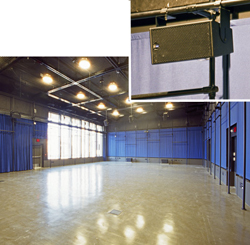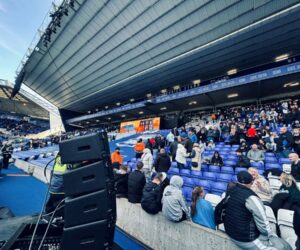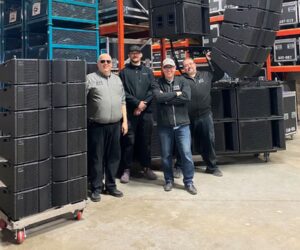At the University of California, San Diego (UCSD) , the recent opening of the $53 million Conrad Prebys Music Center unveiled a futuristic complex where digital technology meets emerging forms of musical expression.
Under one roof, carefully designed acoustical spaces are combined with Meyer Sound audio technology, including Constellation electroacoustic architecture, to provide students with an innovative performance and rehearsal environment to complement the school’s distinguished education program in new music.
A domed mosaic of polygons already winning praise for its exceptional acoustics, the Cyril Harris-designed concert hall—equipped with a Meyer Sound surround system—is considered by most as the architectural centerpiece.
But for composers and performers who wish to select the optimal acoustical environment for different types of presentations, the spotlight shifts to the 150-seat Experimental Theatre, where Constellation adds adaptable sonic spaces to the palette of musical creativity.
“We decided early on that the Experimental Theater should have variable acoustics to allow a greater scope for musical expression,” says Peter Otto, the school’s director of music technology. “Our building committee evaluated both physical systems and several electronic systems. In the end, Constellation made the most sense, both musically and economically.
“It offers a variety of environments, going far beyond what would be possible with mechanical systems, including reverberation times up to two seconds. Then, with the push of a touch-screen button, the room instantly becomes an ideal lecture hall, where teachers and students can hear each other clearly without resorting to the hassles of installing a PA system.”
Constellation is a seamlessly integrated electroacoustic solution based on the patented VRAS technology to give venues the ability to supply appropriate acoustics for each kind of performance they host, all accessible with a single button press.
The Experimental Theater system comprises one MS-Constellation master processor, three MS-VRAS processors, 24 cardioid microphones spaced overhead, 40 MM-4XP self-powered miniature loudspeakers overhead and on the walls, and ten compact UMS-SM subwoofers for extending response to the lower registers.
The complete system also includes nine UPJ-1P VariO loudspeakers and two 500-HP subwoofers, which can be either integrated into Constellation or used separately as a 7.1 surround system.
Eight presets are programmed into the system to accommodate uses ranging from lectures and conferences to chamber music and “otherworldly” electronic compositions. Five different reverberation times (including off) between 0.4 and 2.0 seconds are coupled to varying combinations of early decay time and reverberation time to create the eight room characteristics.
Otto is mindful of the cost savings offered by the Constellation approach, both initially and over time. “Constellation initially costs less than extensive systems of moving panels, drapes, and external chambers,” he observes. “Also, there are no moving parts to wear out and replace, no labor required to move portable walls or shells, and no need to set up PA systems for lectures. Over 10 to 20 years, those savings add up.”
As with all Constellation systems, design and commissioning were handled by Meyer Sound’s Constellation team, working in consultation with principal architect Mark Reddington of Seattle-based LMN Architects. Sound Image of Escondido, Calif., installed the system under the leadership of Division Director Glenn Peacock.
According to Peacock, the UCSD Constellation project was the first of its kind for his company, though others are already in the works. “I can definitely tell you that Constellation is in a class by itself in electroacoustics,” he says. “The latitude it offers for digitally managing a listening experience goes significantly beyond the other systems I’ve heard.”
The Conrad Prebys Music Center’s larger 400-seat concert hall follows the physical approach to acoustical design—in this case the inspired work of legendary acoustician Cyril Harris in collaboration with Ashton Taylor of HFP Acoustical Consultants in Houston.
To accommodate both acoustical and electronic music, the room features a surround system of 12 Meyer Sound UPJ-1P loudspeakers, each meticulously calibrated to blend seamlessly with the room acoustics.
“The UPJs have the musicality, the openness, and the transparency we needed for a wide variety of sounds, from orchestral instruments to jazz and electronic,” says Otto. “It’s the standard speaker that we’re using throughout the building.”
The third large performance space in the music center, a 150-seat rehearsal/recital hall, employs a surround system of seven UPJ-1P loudspeakers. All AV systems in the concert and recital/rehearsal halls were designed in consultation with Ron Simonson of CCI Solutions in Olympia, Wash., with installation by Anderson Audio Visual of San Diego.
Additional Meyer Sound loudspeakers and Matrix3 audio show control systems are deployed extensively at UCSD’s nearby Atkinson Hall, home of the CalIT2 Research Center.
The building’s Digital Cinema Auditorium utilizes Cinema Experience loudspeakers as a complement to its 4k digital video projection, while more than two dozen UltraSeries and miniature MM-4 loudspeakers provide audio support in the black box theater and two cutting-edge virtual reality environments.




















